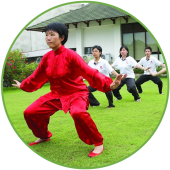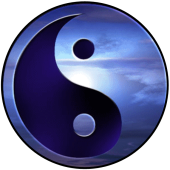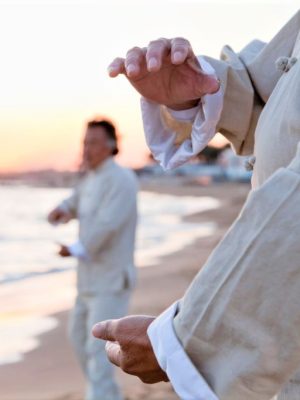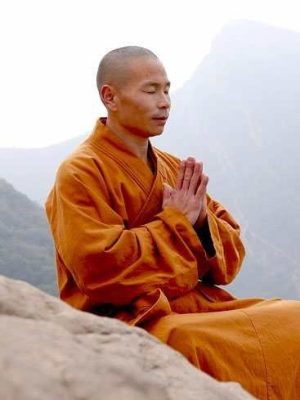Qi Gong

Health Qi Gong
Chinese Healing Art for Mind & Body to Increase Strength & Vitality & Maintain a Healthy Active Life

What is Qi Gong ?
Qi Gong (Chi Kung) means ‘energy practice’ and began around the time of the Yellow Emperor 4500 years ago. It is deeply intertwined with the philosophy of Tao, Yinyang, and the Chinese way of life where it is taught in schools, universities and hospitals. Originally, Qi Gong was based on Taoist and Buddhist healing techniques to improve the flow of Qi (natural healing energy) between humans and nature, and was practiced as a daily self-renewal method to tune the body, breath and mind and bring them into unity.
Popular styles of Qi Gong include; Medical Qi Gong which uses herbs, massage and acupuncture; Martial Qi Gong is practiced by martial artists to increase fighting power; Spiritual Qi Gong is practiced by monks to energize the brain for enlightenment. However, the most popular style is Health Qi Gong, which encourages a regular practice of deep breathing, stretching, energy meditation and healthy diet to increase the quantity and quality of Qi in your body, and can increase strength and vitality to help you maintain a healthy active life.

4 Categories of Qi Gong
Qi Gong can be classified into 4 major categories according to the purpose or final goal of the training. This is only a rough breakdown, however, since almost every style of Qi Gong serves more than one of the above purposes. For example, although martial Qi Gong focuses on increasing fighting effectiveness, it can also improve your health. The Daoist Qi Gong aims for longevity and enlightenment, but to reach this goal you need to be in good health and know how to cure sickness:
- Health Qi Gong for preventing sickness and maintaining health using breathing, stretching and meditation
- Medical Qi Gong for curing sickness using herbs, massage and acupuncture
- Martial Q Gong for energizing the body for sports and combat
- Spiritual Qi Gong for energizing the brain for enlightenment or Buddhahood using all of the above particularly reverse breathing and stillness meditation.

Nei Gong & Wai Gong
Generally speaking all Qi Gong methods of training can be divided into 2 styles: Nei Dan Qi Gong (Nei Gong – internal training) and Wai Dan Qi Gong (Wai Gong – external training). Understanding the difference between them will give you an overview of most styles of Chinese Qi Gong, and increase the effectiveness of your practice according to the training theory and methods of your Qi Gong tradition.
- Nei Gong is regarded as an internal practice that focuses more on mental training. It emphasizes relaxed muscles and mind power to build Qi in the lower abdomen and centre, which then flows out to the organs and throughout the meridian system and whole body. Nei Gong is mainly based on relaxed training exercises and meditations, and normal abdominal breathing (Zheng Hu Xi) to increase the effectiveness of leading Qi inwards.
- Wai Gong is regarded as an external practice that focuses more on physical training. It emphasizes stimulated muscles to build Qi in the skin, arms, legs and extremities, which then flows in to the organs and throughout the meridian system and whole body. Wai Gong is mainly based on vigorous training exercises and meditations, and reverse abdominal breathing (Ni Hu Xi) to increase the effectiveness of leading Qi outwards.

Goals of Practice
- To teach beginners to feel their qi – Beginners usually do not have even the slightest concept of qi. Our courses gradually give you an understanding of qi through feeling and experience. This kind of knowledge is necessary for any kind of advancement in Qi Gong and Tai Chi Chuan. For this reason, beginners are usually taught some of the many simple Wai Dan forms.
- To teach beginners to regulate the body, breathing, and mind – Once you have grasped the idea of qi, you then start to learn to regulate your body. This includes how to relax the body from the skin to as deep as the internal organs and bone marrow. Through this relaxation you are able to feel and sense your center, balance, and root. You must also learn to regulate your breathing—normal abdominal breathing for relaxation and reverse abdominal breathing for qi expansion and condensation. Most important of all, you must learn to regulate your mind until it can be calm and concentrated without disturbance. All of these criteria are the critical keys to the correct practice of Qi Gong and Tai Chi Chuan. If you start learning the sequence without having already done this basic training, you will be preoccupied with the complicated movements and will only be able to perform them in a superficial way.
- To teach beginners to use their mind to lead the qi efficiently – Once you have regulated your body, breathing, and mind, you will then be able to use your concentrated mind to lead the qi to circulate smoothly and effectively.
- To teach practitioners to circulate qi in the twelve primary qi channels and fill up the two main qi vessels – If you are able to use your mind to lead the qi efficiently, you have completed the basic training. This is then the time for forms or sequence training. In addition, you should continue your Qi Gong and Tai Chi Chuan training and learn to build up your concentration to a higher level and, consequently, build your qi to a higher level. In addition, you should also learn to increase the qi in the two main vessels—the yin conception vessel and the yang governing vessel. Still meditation is normally used for this.
- To teach practitioners to expand their qi to the surface of the skin and to condense the qi to the bone marrow – When the body’s qi has been built to a higher level, you then start learning to lead the qi to the skin to increase the skin’s sensitivity and into the bones to nourish the marrow.
- To teach practitioners to use the qi to energize the muscles for maximum jin manifestation – When you are able to lead the qi to the skin and condense it to the marrow efficiently, you can then use this qi to energize the muscles to a high level. This is the secret to internal jin. Internal jin is the foundation and root of external jin.
- To lead advanced practitioners into the domain of spiritual cultivation – The ultimate goal of Qi Gong and Tai Chi Chuan practice is to lead you into the domain of emptiness, where your whole being is in the no-extremity (wuji) state. When you have reached this goal, the qi in your body and the qi in nature will unite and become one, and all human desires will gradually disappear.

Difference Between Tai Chi & Qi Gong
Tai Chi Chuan (Taijiquan) and Qi Gong (Chi Kung) are two forms of mind-body exercise from ancient China that have more similarities than differences. Most people who practice Tai Chi Chuan also incorporate Qi Gong into their practice as they result in similar benefits including increased oxygenation of the whole body, mental calmness and renewed strength and vitality. Tai Chi Chuan and Qi Gong both centre around the philosophy of cultivating Qi, the life force or vital energy in our body. Both involve good posture and gentle movements. Both practices integrate breath with movement and use cognitive skills such as imagery and visualization to heighten awareness of energy circulation.
One major difference is that Tai Chi Chuan was originally created as a martial art with all its movements being either attacking, defensive and neutralizing. Tai Chi Chuan also has partner exercises known as Pushing Hands for developing advanced techniques, self-defense and martial power. Health Qi Gong is not a martial art and does not have any self-defense movements or Pushing Hands exercises. Health Qi Gong can be practiced sitting, standing and moving, but Tai Chi Chuan only has moving exercises. People get confused because when practiced slowly for health and relaxation Tai Chi Chuan is categorized as a form of Health Qi Gong.
However, both are easy to do, benefit everyone, and the results can be extraordinary. Each lesson builds on the next which helps to create a conversation of sensing, feeling and relaxing that engages your whole being in a process where old habits can be replaced by new awareness and skill. To train the mind to deeply connect with the language of the body is an art that requires guidance form a teacher and regular practice. As your own inner wisdom awakens it guides you through your healing journey and beyond.

How It Works
Health Qi Gong is a unique and comprehensive approach to personal development based on Yin Yang philosophy and Traditional Chinese Medicine for cultivating Qi, where good health is regarded as a result of a free-flowing, well-balanced energy system. Physical, mental and emotional illness occurs when Qi flow is blocked or impeded, or when there is excess or deficient water (Kan) and fire (Li) causing imbalance and dysfunction in the body’s energy system. With regular practice Health Qi Gong cleanses the body of toxins, restores energy and balance, reduces stress and anxiety, and helps maintain a healthy and active life.
Health Qi Gong practitioners can practice both Nei Gong and Wai Gong , depending on your Qi Gong tradition, to develop sensitivity to Yin Yang imbalances in the body, and learn to guide their energy back into balance. This can lead to self-healing skills and the ability to work with the natural energies of the universe to heal one self and others. Mastering these skills takes many years of training, patience and effort, leading to profound wisdom and spiritual growth, and what the ancient masters refer to as ‘Becoming One with the Tao’.

5 Regulators of Qi Gong
Body – the battlefield – Starting with the body, we balance between strength and flexibility, which is one of the first steps on a physical level to help the energetic system. By finding balance between your strength and flexibility, stagnation will be removed and the system will be one step closer to its full potential performance. The lack of balance between strength and flexibility creates stress on the energy channels and does not allow the mind to flow smoothly through the body, leading to an unbalanced situation within the system. One other step is massaging the internal organs through movement or through self-massage. By massaging the internal organs, you remove and circulate energy that is stagnant in the organ area; you lead it into the channels and out throughout the extremities. Also, working with the joints allows the energy to move smoothly between the bones and the muscles, and between the inside and the outside. Maintaining flexibility in the joints, tendons, muscles, and ligaments is very important.
Breath – the strategy – Through developing the second regulator, the breath, we increase and improve the function of the lungs, allowing more energy to move in. We are supplying every cell in our body with more oxygen, allowing those cells to function and perform better. Moving more oxygen in and more carbon out is a process that also helps you attain a more balanced energetic system. By developing the lungs, you not only take in more oxygen, but also train the mindfulness of your breathing that in turn develops the skill of using the banana to capture the monkey.
Mind – the general – The third is the mind. The mind is probably the most important aspect of balancing the energetic system. Emotions can create excitement or depression, which leads to lack of balance in the energetic system. If it were only up to the emotional mind, we would not have a balanced system. We are able, however, to monitor ourselves and calm the emotional mind using breathing or other methods. The Taoists refer to this process as “seize the monkey and strengthen the horse.” When the monkey is quiet, it will allow the energy to be strong and balanced, which can eventually allow you to connect and harmonize with the energy of the three forces: heaven, human, and earth.
Qi – the army – The fourth is qi; our energetic system. There are two major schools of thought: the first believes that through fine-tuning until fine-tuning is not needed, each of the other blocks will fall into place naturally. The second believes that all five building blocks need to be fine-tuned, especially the energetic one. The second school of thought is more Taoist than Buddhist. You can find a world of energetic visualizations in Taoist thought that you will not find anywhere else. My personal experience is that both schools have excellent tools so I use the best from both worlds. Some individuals can work and practice every block except the energetic one and will get excellent results, and others will not get results, in which case, focusing on the energetic block sometimes achieves results. That is the reason I keep my mind open and I first try to sense which block will be the most appropriate for each individual to clear.
Spirit – the morale – Through developing the fifth regulator, the spirit, we boost our energetic system to places that words cannot describe. Learning to evoke the spirit can lead to abundant energy and great spiritual achievement. The energetic system consists of two elements, fire and water. The theory is that the system is fiery to start with because of the food we eat and the air we breathe. Because we are more fire than water, we need to constantly cool or calm down the system for the simple goal of achieving balance. One of the methods of cooling the fire is through strengthening and draining the internal energetic baton within the core of the body. After we strengthen the energy centres, we connect the upper and the lower energy centre. This connection creates a baton of energy: two balls of energy in the head and the abdomen and the line connecting them. This baton of energy can become stronger and stronger. The baton is in charge of managing the functions and the operation of the inner body including the immune system. The stronger your baton is, the stronger your immune system is. The Chinese refer to this part of the energetic system as managing qi. Surrounding the body, we have a bubble or the energy that is about a fist away from our skin, all around us. It is the energy mechanism that deals with forces around us. This energetic bubble behaves as a shield and also as a filter. The stronger your system is, the more efficient this filter is and the better its ability to strain and filter negative forces, as well as deal with positive forces. An efficient filter will allow positive constructive energies to move in and allow negative energies to leave the body. This efficient process is another key element to having a better-balanced system, healthier life, and a stronger performance on a daily basis. As you can see, once we fine-tune the system, remove the stagnation, build up the centre, create a stronger flow, and upgrade the shield and filters, we are one step ahead in dealing with better health. We are now in a state of prevention. Cultivating longevity, and not just health, involves prevention, which requires spending time and energy even when you are not sick and even when you are in your best shape, in order to achieve more success as you age.
